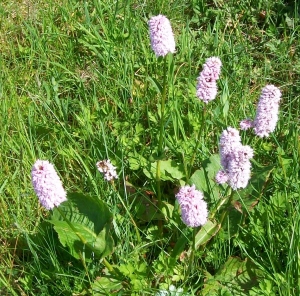
- Bistort at Breakish
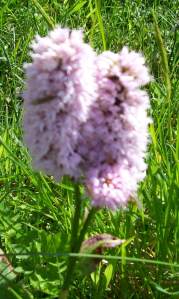
Two on one stalk


Two on one stalk
A few very wet days have given me the opportunity to do some more work on the Flora of Raasay & Rona. I have expanded the history section and added sections on old records. Almost all the bits marked in red as being in need of tidying up have been sorted. A few first record dates are awaiting replies from the folks who (may have) made them.
I put a counter and search facility on the site a little over a week ago and 74 different people have visited the Flora website since then. Given its specialist nature and the fact that I wasn’t counting during the “launch” period, that seems pretty satisfying.
Three Chara specimens collected on Eigg last June have now been determined as Chara virgata (Delicate Stonewort), the one from Loch na Beinne Buidhe being the var. annulata. C. virgata is the commonest charophyte on Raasay and Rona and probably throughout the rest of the vice-county, though Nitella flexilis/opaca (Smooth Stonewort is probably under-recorded.
That just leaves Utricularia (Bladderwort) specimens awaiting expert determination. They were probably all U. minor.
During this week’s visit to Eigg at the top of a sandy beach we found nettles with strange things like this:
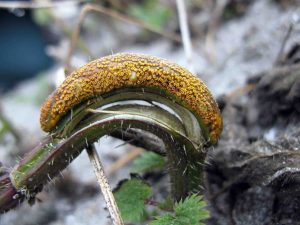
At first we thought they were slugs that had died of a fungal infection but they turn out to be nettle galls caused by a rust fungus Puccinia urticata. Thanks to Carl Farmer for the i.d.
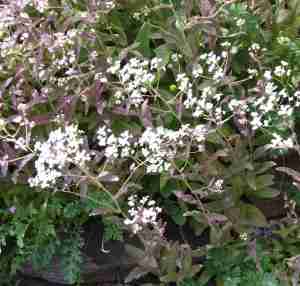
Peltaria at Armadale
Ian Hedge at RBGE identified it as a Peltaria – a shieldwort, so called after the shape of the fruits:
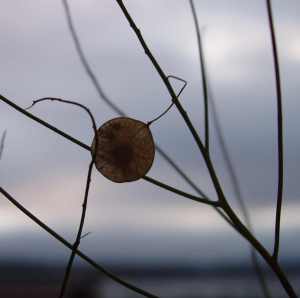
Peltaria fruit
I recently obtained another specimen and it is now clear that the plant is Peltaria alliacea (Garlic Cress) – the key diagnostic character being the leaf base:
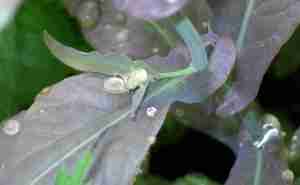
Peltaria alliacea leaf base
This is probably the first record for it naturalised in the British Isles. It is occasionally grown in gardens and is native in Eastern Europe and the Middle East.
The other major activity on Eigg was to look for Hazel Gloves (Hypocreopsis rhododendri) a rare fungus that grows on hazel in the British Isles and is probably the same as the organism that grows on Rhododendron maximum in North America (hence the scientific name). We found two sites in our short visit which was very satisfactory. I have now seen it on Skye, Eigg and Mull. There is much more about this species at the UK BAP website. The picture shows it on Skye:
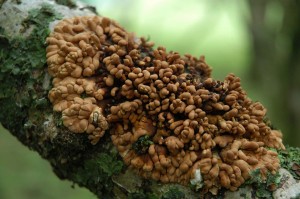
Image from Roger Cottis
Yesterday, I went to Eigg with the Skye & Lochalsh branch of the Scottish Wildlife Trust. This meant two nights away on Skye as the ferry times mean that I could neither get to Armadale in time on Monday morning, nor get back on Monday night.
The group I was with spent the day in tetrad NM48X around Kildonan and we added Hypericum perforatum (Perforate St John’s-wort) and Veronica persica (Common Field-speedwell) to the Eigg list. They were both present as weeds in a vegetable garden. We also found Moehringia trinervia (Three-nerved Sandwort) which we did not see during our botanical blitz of Eigg last June, but for which there are older records.
Something like sixteen taxa were added to the 2008 records for NG48X including Atriplex laciniata (Frosted Orache), Cakile maritima (Sea Rocket), Persicaria amphibia (Amphibious Bistort) and Valerianella locusta (Common Cornsalad or Lamb’s Lettuce).

Young Atriplex lacianata on Eigg Photo: Roger Cottis
Just returned from two days on Rona, shortly leaving for trip to Eigg tomorrow.
Highlights: Ophioglossum vulgatum (Adder’s-tongue) and Solanum tuberosum (Potato) are new to the Rona list. Ophioglossum azoricum (Small Adder’s-tongue) is new to the ten km square NG65 on Rona.
Lots of additional tetrad records – a new site for Calamagrostis epigejos (Wood Small-reed) in the south.
Today I climbed Beinn na Caillich (Hill of the Old Woman), one of the red Cuillins and a gentle 732m. First, however, I botanised along the Allt Beinn Deirge and re-found a 1972 record for Dryas octopetala (Mountain avens). With it was Anthyllis vulneraria (Kidney Vetch) and more pleasingly Persicaria vivipara (Alpine Bistort) which is scarcer locally.
The hill yielded many of the expected plants – Cryptogramma crispa (Parsley Fern), Vaccinium vitis-idaea (Cowberry), Juniperus communis ssp. nana (Juniper), Diphasiastrum alpinum (Alpine Clubmoss), Alchemilla alpina (Alpine Lady’s-mantle) – but it was perhaps a little early in the season for Luzula spicata (Spiked Wood-rush) and Juncus trifidus (Three-leaved Rush). There again, I ran out of time as I had to be in Breakish for 2 pm for a meeting of the Skye & Lochalsh Environmental Forum.
A warm day, 21C according to the car and 20C on Skye according to the BBC. Also a very fine ptarmigan on the hill.
I spent the day around Portnalong on Skye. A beautiful day with my first green hairstreak butterfly of the year as well as the usual skylarks and cuckoos.
There is a fine gorge where the Eisgill Burn heads towards the sea with its banks covered with Orchis mascula (Early-purple Orchid), Trollius europaeus (Globeflower) and Rubus saxatilis (Stone Bramble).
The best finds were Lepidium heterophyllum (Smith’s Pepperwort), an uncommon plant in the vice-county, and a possible specimen of Cirsium x wankelii (C. heterophyllum (Melancholy Thistle) x C. palustre (Marsh Thistle)). It had pinnatifid leaves and six capitula but otherwise looked like the nearby C. heterophyllum. A further inspection later in the season is called for.
There were some unexpected plants on the roadside, probably from imported soil – Lilium pyrenaicum (Pyrenean Lily), Aconitum napellus(Monk’s-hood) (probably) – and elsewhere on the roadside Lysimachia punctata (Dotted Loosestrife), Geranium lucidum (Shining Crane’s-bill) and Spiraea x pseudosalicifolia (Confused Bridewort).
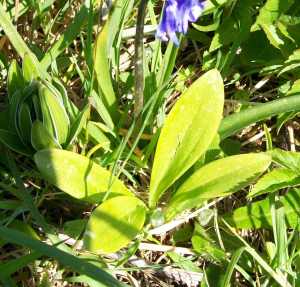
Unidentified alien on roadside at Portnalong
On the shore I found Suaeda maritima (Annual Sea-blite), Aster tripolium (Sea Aster), Juncus gerardii (Saltmarsh Rush) and Puccinellia maritima (Common Saltmarsh-grass) but I was perhaps a little early in the season for the previously recorded Polygonum oxyspermum subsp. raii (Ray’s Knotgrass) and Salicornia sp. (Glasswort).
Mike Wilcox read here about the molecular work on Ophioglossum and wondered if there is any difference in the sterile fronds by way of stomata etc. I sent him samples of O. azoricum and O. vulgatum a few days ago and he says he found them to be quite different. The test will be to send him some blind, including some of the odd-looking azoricum fronds. It would be handy to have a guaranteed means of distinguishing these species without resorting to molecular studies.